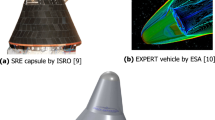Abstract
To effectively reduce the computational loads during the optimization process, while maintaining the solution accuracy, a refined response surface method with design space transformation and refined RSM using sub-optimization for the regression model is proposed and implemented for the nose fairing design of a space launcher. Total drag is selected as the objective function, and the surface heat transfer, the fineness ratio, and the internal volume of the nose fairing are considered as design constraints. Sub-optimization for the design space transformation parameters and the iterative regression model construction technique are proposed in order to build response surface with high confidence level using minimum number of experiment points. The derived strategies are implemented to the nose fairing design optimization using the full Navier-Stokes equations. The result shows that an optimum nose fairing shape is obtained with four times less analysis calculations compared with the gradient-based optimization method, and demonstrates the efficiency of the refined response surface method and optimization strategies proposed in this study. The techniques can be directly applied to the multidisciplinary design and optimization problems with many design variables.
Preview
Unable to display preview. Download preview PDF.
Similar content being viewed by others
References
Vanderplaats, G.N., Hicks, R.M.: Numerical Airfoil Optimization Using a Reduced Number of Design Coordinates. NASA TM X-73, 151 (1976)
Ong, Y.S., Nair, P.B., Keane, A.J.: Evolutionary optimization of computation-ally expensive problems via surrogate modeling. American Institute of Aeronauticsand Astronautics Journal 41(4), 687–696 (2003)
Myers, R.H., Montgomery, D.C.: Response Surface Methodology. John Wiley & Sons Inc., Chichester (1995)
Venter, G., Haftka, R.T., Starnes Jr., J.H.: Construction of Response Surface Approximations for Design Optimization. AIAA Journal 36(12), 2242–2249 (1998)
Burgee, S., Giunta, A.A., Balabanov, V., Grossman, B., Mason, W.H., Narducci, R., Haftka, R.T., Watson, L.T.: A Coarse-Grained Parallel Variable- Complexity Multidisciplinary Optimization Paradigm. The International Journal of Supercomputer Applications and High Performance Computing 10(4), 269–299 (1996)
Unal, R., Lepsch, R.A., McMillin, M.L.: Response Surface Model Building and Multidisciplinary Optimization Using D-Optimal Designs. AIAA-98-4759 (September 1998)
Harten, A.: High Resolution Shemes for Hyperbolic Conservation Laws. Journal of Computational Physics 49(3), 357–393 (1983)
Yee, H.C., Kolpfer, G.H., Montague, J.L.: High Resolution Shock Capturing Schemes for Inviscid and Viscous Hypersonic Flows. NASA TM 100097 (April 1988)
Lee, J.-W., Min, B.-Y., Byun, Y.-H.: Multi-Point Nose Shape Optimization of Space Launcher Using Response Surface Method. Journal of Spacecraft and Rockets (2004) (accepted for the publication)
Holden, M.S., Moselle, J.R.: Theoretical and Experimental Studies of the Shock Wave-Boundary Interaction on Compression Surfaces in Hypersonic Flow. In: AIAA 89-0458 (January 1989)
Rudy, D.H., Thomas, J.L., Kumar, A., Gnoffo, P., Chakravarthy, S.R.: A Validation Study of Four Navier-Stokes Codes for High-Speed Flows. In: AIAA 89-1838 (June 1989)
Lee, J.Y., Lewis, M.J.: Numerical Study of the Flow Establishment Time in Hy-personic Shock Tunnels. Journal of Spacecraft and Rockets 30(2), 152–163 (1993)
Tak, J.-S., Byun, Y.-H., Lee, J.-W., Lee, J.-Y., Huh, C.-J., Choi, B.-C.: A Numerical Study on the Performance Analysis of Shock Tunnel. In: Proceedings of the Korea Society of Computational Fluids Engineering Spring Annual Meeting (May 2000)
OT Users Manual, Vanderplaats Research & Development, Inc. (1995)
Michalewicz, Z.: Genetic Algorithms + Data Structures = Evolution Programs. Springer, Heidelberg (1996)
Chae, Y.-S., et al.: Research and Development of KSR-III(I) Final Report. Korea Aero- space Research Institute (1998)
Author information
Authors and Affiliations
Editor information
Editors and Affiliations
Rights and permissions
Copyright information
© 2005 Springer-Verlag Berlin Heidelberg
About this paper
Cite this paper
Lee, JW., Jeon, KS., Byun, YH., Kim, SJ. (2005). Optimal Space Launcher Design Using a Refined Response Surface Method. In: Wang, L., Jin, Y. (eds) Fuzzy Systems and Knowledge Discovery. FSKD 2005. Lecture Notes in Computer Science(), vol 3613. Springer, Berlin, Heidelberg. https://doi.org/10.1007/11539506_134
Download citation
DOI: https://doi.org/10.1007/11539506_134
Publisher Name: Springer, Berlin, Heidelberg
Print ISBN: 978-3-540-28312-6
Online ISBN: 978-3-540-31830-9
eBook Packages: Computer ScienceComputer Science (R0)




